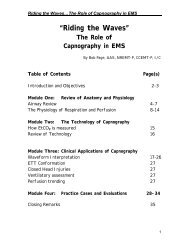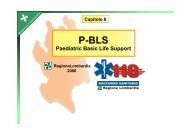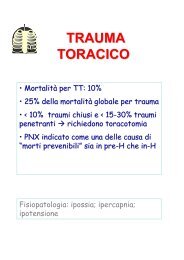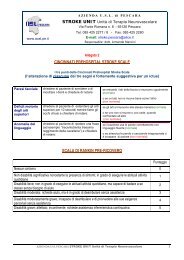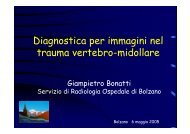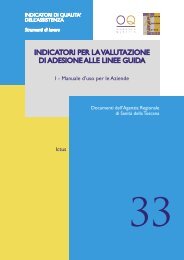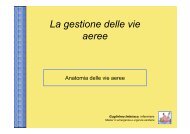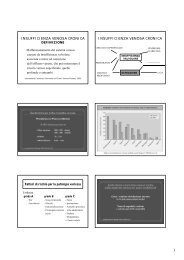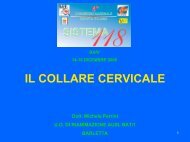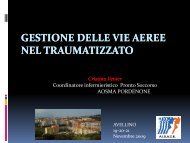Neuromonitoraggio e neuroprotezionismo nel trauma cranico
Neuromonitoraggio e neuroprotezionismo nel trauma cranico
Neuromonitoraggio e neuroprotezionismo nel trauma cranico
You also want an ePaper? Increase the reach of your titles
YUMPU automatically turns print PDFs into web optimized ePapers that Google loves.
<strong>Neuromonitoraggio</strong> e neuroprotezione <strong>nel</strong><strong>trauma</strong> <strong>cranico</strong>Outline• NeuroprotezioneL. LonghiIst Anestesia e RianimazioneUniversita’ MilanoTerapia Intensiva NeuroscienzeFondazione IRCCSOspedale Maggiore Policlinico, Mangiagalli e Regina ElenaMilano• Premesse fisiopatologiche del <strong>trauma</strong> <strong>cranico</strong>• Come fare neuroprotezione attraverso ilmonitoraggiolucalonghi@policlinico.mi.itPathways of cell deathGlutamatePrimaryDamageInsultsSecondaryDamageCa 2+CalpainMitochondrionROSInflammationCaspasesNeuroprotectionReduction of neuronal degeneration byinterrupting biological mediators of neuronaldeathMarshall, Neurosurgery; 47, 3, September: 546-561, 2000 Arch Neurol. 2007;64:794-8001
Come possiamo fare neuroprotezioneal letto del paziente?Early diagnosis and intensivemanagement• early diagnosis and evacuation of intracranialmass lesions• Early CT scanCT Scan• Do not rely on early negative CT Scans• control of increased intracranial pressure• aggressive medical therapy, includingartificial ventilation.CT Scan• Early CT scanAdmission CT6 hours laterAfter kidney removal• Do not rely on early negative CT Scans• Sequential controls– Scheduled– In case of deterioration• Neuroworsening• ICP rise2
Perche’ fare presto con ematomi?J Neurosurg 95:569–572, 2001 J Neurosurg 95:569–572, 2001Intensive care treatmentVolume-pressure curveGoals of NeuroICUDiagnosis/treatmentof complicationsPrevention/treatment ofsecondary insultsICPmmHg3020100FlexionExtensionFlexionhoursBrain vulnerability to secondaryinsultsChesnut n = 717Secondary insultsMiller n = 225Chesnut RM et al: J Trauma1993Miller JD et al: JAMA 19783
SensitivityTBI and ischemia• Altered ability of the brain to withstand a secondinsult or a second TBImild TBILaboratory investigation:+sub-thresholdinsultAlterazioni del flusso ematico cerebrale dopoFluid Percussion Injury% Pre-Injury values11010090Time (minutes)(hours)0 15 30 1 2 4 24Acute HyperglycolysisNMDA receptor-mediated release of K+ resulting in anincrease demand for glucose along with the production oflactate80Max706050Min4030(Yamakami & McIntosh, 1991)[ 14 C]-iodoantipyrineautoradiographyMismatch of CMRglc and CBF following TBIStato di vulnerabilita’richiesta diglucosioTraumaCrisienergeticaCT(raw)10.7 lCMRglc 8.6 20 rCBF 37mg/100g/minml/100g/minFlussoematicocerebraleApporto diglucosio4
CrisicomizialiInsulti secondaririchiesta diglucosioSusceptibilityInability to maintain a physiological CBF in responseto a reduced MAP, PaO2 and anemia after TBIleading to cerebral ischemiaFebbreCarenza diossigenoRiduzione dellapressioneFlussoematicocerebraleFallimento Crisienergetico energeticaApporto diglucosioMorte cellulare edannineurologiciBrain pathophysiology cannot beassumed, it should be investigatedJ Neurosurg. Volume 75. November, 1991Indications for ICP monitoringhttp://www.brain<strong>trauma</strong>.org/5
ICP, Cerebral Perfusion PressureCPP = MAP -ICPCBF = CPPCVR1970 1980 1990 2000JOURNAL OF NEUROTRAUMA Volume 24, Supplement 1, 2007AJDO 2 (vol/dl)1086Ischemia4InfarctionCMRO 220 40 60 80 100CBF (mL/100g/min)Robertson CS, et al: J Neurosurg 70:222-230, 1989• Without raised ICP there is no indication forhyperventilation• Hyperventilation may be considered under carefulmonitoring of cerebral oxygenation– SJO 2 , AJDO 2 , PtiO 2Stocchetti N et al: Anesth Analg 2004CHEST 2005; 127:1812–18276
PbtO 2 19-10 mmHgPbtO 2 < 10 mmHg• Low CPP: 4.8%• AjDO 2 normal• Low CPP: 17%• AjDO2 normalEpisodes of regional brain hypoxia undetectedby other measures of brain oxygenationLonghi et al. Intensive Care Med DOI 10.1007/s00134-007-0845-2Journal of Neuro<strong>trauma</strong>. 2005, 22(1): 3-41AnalytesAnalytesGlucoseLactatePyruvateEnergyGlucoseLactatePyruvateGlutamateGlutamateExcitotoxicityGlycerolGlycerolAnalytesGlucoseLactatePyruvateGlutamateGlycerolMembranedisruption7
706050403020100ICPmICPmaxCPPmCPPlow0 1 2 3 4 5 6 7 8 9 10 11 12 13 14 15 16 17 18 19 20 21 22 23 24 2530702570206015PtO2L/P6050105504004030302010ICPmICPmaxCPPmCPPlow2010ICPmICPmaxCPPmCPPlow00 1 2 3 4 5 6 7 8 9 10 11 12 13 14 15 16 17 18 19 20 21 22 23 24 2500 1 2 3 4 5 6 7 8 9 10 11 12 13 14 15 16 17 18 19 20 21 22 23 24 2570605040302010ICPmICPmaxCPPmCPPlow00 1 2 3 4 5 6 7 8 9 10 11 12 13 14 15 16 17 18 19 20 21 22 23 24 258
30702570206015PtO2L/P6050105504004030302010ICPmICPmaxCPPmCPPlow2010ICPmICPmaxCPPmCPPlow00 1 2 3 4 5 6 7 8 9 10 11 12 13 14 15 16 17 18 19 20 21 22 23 24 2500 1 2 3 4 5 6 7 8 9 10 11 12 13 14 15 16 17 18 19 20 21 22 23 24 257060MannitolHyperventilationSedationWhy does temperature matter?504030VasopressorsBarbiturates2 nd DecompressionHypoHyper20100ICPmICPmaxCPPmCPPlow0 1 2 3 4 5 6 7 8 9 10 11 12 13 14 15 16 17 18 19 20 21 22 23 24 25Temperature:modulator of secondary brain damageJ Neurol Neurosurg Psychiatry 71:448-454, 2001 J Neurol Neurosurg Psychiatry 71:448-454, 20019
mmHg35°C40.2302539.039.739.238.7201510537.838.237.737.236.736.2ICPICT1 2p< 0.05Rossi S, et al J Neurol Neurosurg Psychiatry 2001ICPCPPAJDO2NeurochemistryGlucoseLactatePyruvateGlutamatepO2t°• 328 vs 264 patients• NICU-associated mortality• Hospital LOS• Disposition• Chart documentationJ Neurosurg 104:713–719, 2006• experienced Neurointensivist at bedside• attention to details• better monitoring procedures… Available therapies did not really change during this time;they were simply applied in a more timely and consistent fashion.• pre-hospital care• imaging• surgery• critical care• monitoring• rehabilitationJ Neurosurg 104:709–710, 2006Neurosurgery 47:546–561, 200010



